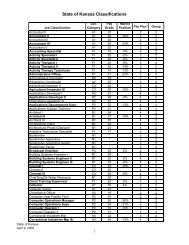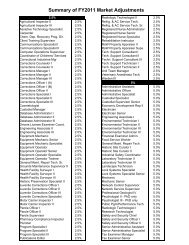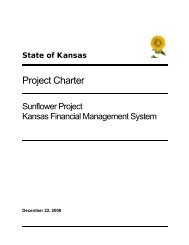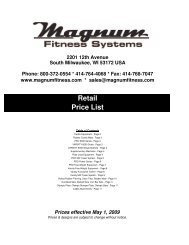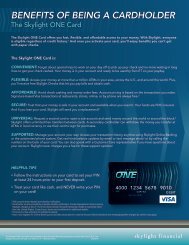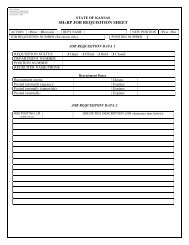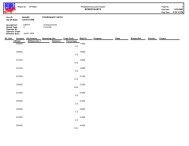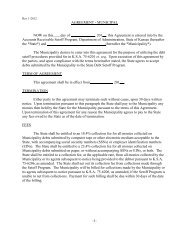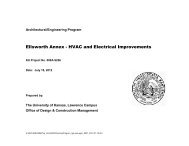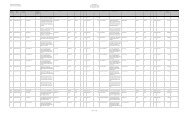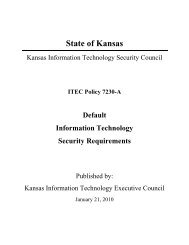State of Kansas Employee Award and Recognition Program ...
State of Kansas Employee Award and Recognition Program ...
State of Kansas Employee Award and Recognition Program ...
You also want an ePaper? Increase the reach of your titles
YUMPU automatically turns print PDFs into web optimized ePapers that Google loves.
<strong>State</strong> <strong>of</strong> <strong>Kansas</strong><br />
<strong>Employee</strong> <strong>Award</strong> <strong>and</strong> <strong>Recognition</strong><br />
<strong>Program</strong><br />
Reference Book
<strong>Employee</strong> <strong>Award</strong> <strong>and</strong> <strong>Recognition</strong> <strong>Program</strong> Reference Book<br />
Table <strong>of</strong> Contents<br />
Section<br />
Page<br />
I. Introduction<br />
Reference Guide Introduction<br />
The Importance <strong>of</strong> <strong>Employee</strong> <strong>Recognition</strong><br />
Role <strong>and</strong> Responsibilities <strong>of</strong> Managers<br />
3<br />
3<br />
3<br />
4<br />
II. Developing a Successful <strong>Award</strong> <strong>and</strong> <strong>Recognition</strong> <strong>Program</strong><br />
Step One: Define the <strong>Program</strong>’s Scope <strong>and</strong> Direction<br />
Step Two: Develop a Budget<br />
Step Three: Establish the <strong>Program</strong> Guidelines<br />
Step Four: Choose the <strong>Award</strong>s<br />
Step Five: Communicate the <strong>Program</strong><br />
Step Six: Present the <strong>Award</strong>s<br />
4<br />
4<br />
5<br />
5<br />
6<br />
7<br />
7<br />
III. <strong>Award</strong> <strong>and</strong> <strong>Recognition</strong> Ideas<br />
No or Low Cost <strong>Recognition</strong> Ideas<br />
Moderate or Higher Cost <strong>Recognition</strong> Ideas<br />
7<br />
7<br />
8<br />
Appendix A: Resources<br />
9<br />
Page 2 <strong>of</strong> 11
I. Introduction<br />
This reference book should serve as a tool for agencies in developing their<br />
agency award <strong>and</strong> recognition program. It provides information on the<br />
importance <strong>of</strong> recognition in the workplace, guidelines to assist agencies in<br />
developing a customized program, as well as recognition ideas. An appendix is<br />
also included to assist the agency manager or program coordinator in developing<br />
the agency’s program.<br />
The Importance <strong>of</strong> <strong>Employee</strong> <strong>Recognition</strong><br />
The implementation <strong>of</strong> effective award <strong>and</strong> recognition programs can<br />
create a positive working environment that encourages employees to thrive.<br />
<strong>Recognition</strong> makes employees feel valued <strong>and</strong> appreciated, it contributes to<br />
higher employee morale, increases organizational productivity, <strong>and</strong> can aid in<br />
recruitment <strong>and</strong> retention. <strong>Recognition</strong> is a powerful motivator. It serves to<br />
reinforce the enthusiasm, commitment, <strong>and</strong> social conscience <strong>of</strong> employees <strong>and</strong> is<br />
a great vehicle for conveying the agency mission <strong>and</strong> goals.<br />
What is most important in an award <strong>and</strong> recognition program?<br />
To Senior Management<br />
To <strong>Employee</strong>s<br />
To Managers <strong>of</strong><br />
<strong>Program</strong>s<br />
• Increases productivity<br />
• Produces Return on<br />
Investment (ROI)<br />
• Improves attitudes<br />
• Builds loyalty <strong>and</strong><br />
commitment<br />
• Generates positive<br />
feedback<br />
• Empowers the workforce<br />
• Assures efficiency<br />
(<strong>State</strong> <strong>of</strong> Virginia 2000)<br />
• Satisfies recognition needs<br />
• Creates a positive recognition<br />
experience<br />
• Provides a wide selection <strong>of</strong><br />
attractive, personalized awards<br />
• Provides timeliness <strong>of</strong> recognition<br />
• Guarantees quality <strong>of</strong> award<br />
• Fosters open communication <strong>of</strong><br />
appreciation<br />
• Provides value for employees.<br />
• Includes efficient<br />
administration<br />
• Excites employees<br />
• Creates pride<br />
• Pleases management<br />
• Involves all employees<br />
• Develops a partnership<br />
with the workforce<br />
• Adds value for<br />
employees<br />
Page 3 <strong>of</strong> 11
The Role <strong>and</strong> Responsibilities <strong>of</strong> Managers<br />
Managers can use recognition as a leadership tool. It can convey a strong<br />
message to employees regarding the work performance <strong>and</strong> behavior that is valued by<br />
their managers. By communicating these essential values, employees will underst<strong>and</strong><br />
how their performance directly contributes to the agency’s ability to achieve its goals.<br />
The role <strong>of</strong> the Agency Human Resource manager is to:<br />
• Provide policy review <strong>and</strong> interpretation;<br />
• Initiate training for supervisors, managers, <strong>and</strong> award program<br />
coordinators in the implementation <strong>and</strong> delivery <strong>of</strong> the recognition<br />
program ;<br />
• Serve as a resource <strong>and</strong> advocate to the agency on the employee award<br />
<strong>and</strong> recognition program; <strong>and</strong><br />
• Promote <strong>and</strong> communicate the award program to the agency.<br />
Agency management, if feasible, ensures the availability <strong>of</strong> funds to support the<br />
costs incurred by the employee award <strong>and</strong> recognition program. Agency management is<br />
encouraged to:<br />
• Allocate resources to implement the program <strong>and</strong> provide internal training<br />
for the award program.<br />
• Promote <strong>and</strong> serve as an advocate for the agency’s employee award <strong>and</strong><br />
recognition program.<br />
All levels <strong>of</strong> management should be well trained in the elements <strong>of</strong> recognizing<br />
<strong>and</strong> rewarding employees. It is essential that every manager <strong>and</strong> supervisor be aware <strong>of</strong><br />
their responsibility to provide effective feedback <strong>and</strong> positive reinforcement to their<br />
employees. To cultivate a successful recognition program, all managers <strong>and</strong> supervisors<br />
should:<br />
• Learn ways to motivate <strong>and</strong> inspire others;<br />
• Learn how to communicate needs, expectations, <strong>and</strong> goals clearly;<br />
• Explain how the program works <strong>and</strong> how employees can receive<br />
recognition; <strong>and</strong><br />
• Provide employees with an underst<strong>and</strong>ing <strong>of</strong> how they impact the<br />
organization’s goals, mission <strong>and</strong> success.<br />
II. Developing a Successful <strong>Award</strong> <strong>and</strong> <strong>Recognition</strong> <strong>Program</strong><br />
Step One: Define the <strong>Program</strong>’s Scope <strong>and</strong> Direction<br />
• What are the goals <strong>and</strong> objectives <strong>of</strong> the program?<br />
It is important in the development <strong>of</strong> any program that the goals <strong>and</strong> objectives, or<br />
what is hoped to be achieved, are understood by all those participating in the process. In<br />
order for a program to be cost effective <strong>and</strong> survive in the long-term, the results <strong>of</strong> the<br />
program must contribute to the achievement <strong>of</strong> the organizational mission. The award<br />
Page 4 <strong>of</strong> 11
<strong>and</strong> recognition program should focus on acknowledging those accomplishments <strong>and</strong><br />
behaviors that contribute to the organization’s mission <strong>and</strong> demonstrate organizational<br />
values. It should be cautioned that recognition <strong>of</strong> behaviors unrelated to the<br />
organization’s mission might lead to an ineffective program. These established program<br />
goals <strong>and</strong> objectives should clearly reflect the organization’s values, mission, <strong>and</strong> vision<br />
for the future. Examples <strong>of</strong> program goals may be:<br />
• Improving safety<br />
• Honoring long-term employment<br />
• Acknowledging creativity that results in new <strong>and</strong> innovative procedures<br />
• Recognizing excellent customer service<br />
• Acknowledging employees <strong>of</strong> the week, month, quarter, or year<br />
• Acknowledging positive attitudes<br />
• Honoring highly skilled employees<br />
• Honoring team players<br />
• Honoring retiring employees<br />
• Recognizing community volunteers<br />
• Recognizing employees who utilize KQM tools <strong>and</strong> principles<br />
An agency may select any number <strong>of</strong> goals <strong>and</strong> objectives to suit their individual<br />
program.<br />
Step Two: Develop a Budget<br />
It is important to consider the impact <strong>of</strong> the <strong>Employee</strong> <strong>Award</strong> <strong>and</strong> <strong>Recognition</strong><br />
<strong>Program</strong> on the agency’s budget. It is also important to remember that even with a<br />
limited budget, there are many ways to recognize employees with little or no cost.<br />
Depending on the amount <strong>of</strong> the allotment to the program, there are alternatives to fit any<br />
budget. The following considerations may be useful in developing a budget for the<br />
program:<br />
• The potential number <strong>of</strong> award recipients in a set time frame;<br />
• The types <strong>and</strong> subsequent costs <strong>of</strong> the awards;<br />
• Costs associated with the presentation <strong>of</strong> the awards;<br />
• The costs <strong>of</strong> promotional <strong>and</strong> informational materials;<br />
• Administrative costs; <strong>and</strong><br />
• Costs associated with the training <strong>of</strong> managers <strong>and</strong> supervisors.<br />
book.<br />
A list <strong>of</strong> award <strong>and</strong> recognition ideas are included in Section III <strong>of</strong> this reference<br />
Step Three: Establish the <strong>Program</strong> Guidelines<br />
The <strong>Employee</strong> <strong>Award</strong> <strong>and</strong> <strong>Recognition</strong> <strong>Program</strong> Guidelines, established by the<br />
Division <strong>of</strong> Personnel Services, provide the basic parameters for which each agency<br />
should develop their own program. Agencies may select any number <strong>of</strong> the five award<br />
categories they want to recognize employees for: Distinguished Accomplishment;<br />
Page 5 <strong>of</strong> 11
Meritorious Service; Innovation; <strong>Kansas</strong> Quality Management; <strong>and</strong> Volunteerism.<br />
Agencies are required by regulation to recognize employees for the Length <strong>of</strong> Service<br />
category. Agencies have flexibility in the types <strong>of</strong> awards or recognition given (monetary<br />
<strong>and</strong> non-monetary), <strong>and</strong> in the nomination <strong>and</strong> selection processes. Agencies have the<br />
option to set limits on the number <strong>of</strong> awards employees can receive in a fiscal year <strong>and</strong><br />
are able to structure the program to best fit work unit <strong>and</strong> agency needs. Consideration<br />
should be given to the goals <strong>of</strong> the proposed program, as well as the scope <strong>and</strong> budget <strong>of</strong><br />
the program. Refer to the program guidelines for more information.<br />
The award program should be evaluated on a regular basis to ensure that program<br />
goals <strong>and</strong> categories continue to be effective, are fresh, <strong>and</strong> align with the work unit or<br />
agency objectives. The agency may want to consider surveying employees about the<br />
program to determine how well the program is being received throughout the<br />
organization.<br />
Step Four: Choose the <strong>Award</strong>s<br />
It is important to give some thought when choosing awards. The award or<br />
recognition should spark motivation <strong>and</strong> perhaps inspire employees to achieve the goals<br />
or to emulate the behavior that the award is associated with. During the development <strong>of</strong> a<br />
program that incorporates non-monetary <strong>and</strong> monetary awards, it is essential to take into<br />
account that some employees will be award recipients, while others will not be so<br />
fortunate. It is important to be aware <strong>of</strong> how a particular award functions within the work<br />
unit <strong>and</strong> the agency. There is potential to destroy the culture <strong>of</strong> a workplace if the<br />
recognition develops into a series <strong>of</strong> competitive contests, focusing on gifts <strong>and</strong> monetary<br />
awards, rather than on the recognized behaviors <strong>of</strong> employees. This situation can<br />
undermine the goals <strong>of</strong> the program. <strong>Award</strong>s <strong>and</strong> recognition should have value <strong>and</strong><br />
meaning to employees. The success <strong>of</strong> the program depends on employee buy-in.<br />
There are several methods <strong>of</strong> recognition that can be delivered to any one<br />
employee. It can be as simple as verbal praise or as elaborate as a tangible gift or<br />
monetary award <strong>and</strong> will likely result in increased productivity, motivation, <strong>and</strong> much<br />
more. A reward should be:<br />
• Sincere: A reward should reflect a genuine expression <strong>of</strong> appreciation.<br />
Shallow acknowledgements leave something to be desired <strong>and</strong> are <strong>of</strong>ten<br />
mish<strong>and</strong>led.<br />
• Meaningful: To elicit a motivating influence, rewards should be aligned with<br />
the values, goals, <strong>and</strong> priorities <strong>of</strong> the organization.<br />
• Adaptable: A diverse workplace dem<strong>and</strong>s alternative recognition methods.<br />
Consider creative options to keep the program “fresh.” Remember, no single<br />
reward format works for everyone all the time.<br />
• Relevant: Some personal dimension is essential to any good reward. No<br />
matter how formal or informal, expensive or affordable, the relevance <strong>of</strong> any<br />
recognition will be enhanced with a personal touch. It’s the little things that<br />
make a big difference.<br />
Page 6 <strong>of</strong> 11
• Timely: It is important that a reward addresses the behavior it is intended to<br />
reinforce. It is important not to let too much time pass or the reward may be<br />
devalued.<br />
Step Five: Communicate the <strong>Program</strong><br />
Promotional materials <strong>and</strong> other methods <strong>of</strong> communication could be used to<br />
inform employees about the program. It is essential that employees are aware <strong>of</strong> the<br />
program <strong>and</strong> each award category that will be recognized. <strong>Program</strong> communication is<br />
essential from the start <strong>and</strong> should be an on-going effort. Promotional materials such as<br />
fliers, posters, brochures, bulletins, <strong>and</strong> postings on Intranet sites will remind employees<br />
<strong>of</strong> the program <strong>and</strong> <strong>of</strong> the potential recognition opportunities.<br />
Step Six: Present the <strong>Award</strong>s<br />
The presentation should match the significance <strong>of</strong> the achievement, <strong>and</strong> be worthy<br />
<strong>of</strong> the reason the employee is being recognized. Presentation <strong>of</strong> awards can be formal or<br />
informal. For example, the presentation may be made while one-on-one with the<br />
employee, in front <strong>of</strong> an immediate work unit, or at an agency-wide meeting. There are<br />
many possibilities. Just be sure to make the presentation worthy <strong>of</strong> the reason the<br />
employee is being recognized.<br />
III.<br />
<strong>Award</strong> <strong>and</strong> <strong>Recognition</strong> Ideas<br />
To enhance the agency’s ability to provide meaningful awards <strong>and</strong> recognition, an<br />
agency may solicit awards from area businesses. (Refer to Ethics Commission<br />
Guidelines)<br />
No or low cost recognition ideas<br />
• Personal thank you notes or e-mails<br />
• Write a letter <strong>of</strong> recommendation or commendation to be placed in the<br />
employee’s personnel file<br />
• Free dress-down day<br />
• Good deed awards<br />
• Post on “recognition board” bulletin board, newsletters, <strong>and</strong>/or website<br />
• Hall <strong>of</strong> Fame (photos <strong>of</strong> recognized employees)<br />
• Submit an article about recipient to Intranet or Internet<br />
• Submit an article about recipient to local/regional/national newspaper<br />
regarding employee’s achievement<br />
• Begin a scrapbook that details achievements throughout the year—include<br />
photos<br />
• Ask a senior manager to attend a staff meeting when recognizing employees<br />
for achievements<br />
• Hold a recognition lunch<br />
• An informal party (various foods <strong>and</strong> drink)<br />
Page 7 <strong>of</strong> 11
• Gift certificate to a local restaurant<br />
• Traveling trophy<br />
• Certificate or plaque<br />
• Mugs, pens, tee shirts, etc. with team or agency logo<br />
• Flowers<br />
• Gift certificates for books or CDs<br />
• Movie tickets<br />
Moderate or higher cost recognition ideas<br />
• Polo shirt with agency logo<br />
• Planners<br />
• Portfolios<br />
• Business card holders<br />
• Special name plate<br />
• Gift certificates<br />
• Trophy<br />
• Clocks<br />
• Cash<br />
• Jewelry<br />
• Enrollment to seminar or additional training<br />
• Catered lunch<br />
• Annual picnic<br />
• Membership choices to social or civic groups<br />
• Month <strong>of</strong> free parking<br />
• Office accessories<br />
Page 8 <strong>of</strong> 11
Appendix A: Resources<br />
The following is a compilation <strong>of</strong> research material on recognition <strong>and</strong> rewards<br />
that aided agencies in the <strong>State</strong> <strong>of</strong> Virginia in the development <strong>and</strong> implementation <strong>of</strong><br />
employee award <strong>and</strong> recognition programs (web sites, books, articles <strong>and</strong> sample<br />
programs).<br />
Web Sites:<br />
4.law.cornell.edu/uscode/29<br />
4.law.cornell.edu/uscode/26<br />
recognition.org<br />
incentivemag.com<br />
workforce.com<br />
kudoz.com<br />
fed.org/rerclib/subject.htm#motive<br />
meaninggatwork.com<br />
nelson-motivation.com<br />
ipma-hr.org/research/awardtoc.html<br />
shrm.org<br />
worldatwork.org<br />
bravo.state.az.us/bravo.html<br />
libraries, psu.edu/rewards/thanks.html<br />
southwest.com/careers/stars/stars.html<br />
tasc.dot.gove/HRm/awards.html<br />
uscg.mil/hq/cgpc/cpm/hom/rrhsect1.html<br />
usda.gov/da/employ/recog.html<br />
utexas.edu/admin/ohr/admin/rewards<br />
da.state.ks.us/ar<br />
US Code-Title 29-Labor<br />
US Internal Revenue Code-Title 26<br />
National Association for <strong>Employee</strong><br />
<strong>Recognition</strong><br />
Incentive Magazine<br />
Workforce Online<br />
Dr. Kudoz<br />
Foundation for Enterprise<br />
Development<br />
Meaning at Work<br />
Nelson Motivation, Inc.<br />
International Personnel Mgmt. Assn.<br />
Society for Human Resource Mgmt.<br />
World at Work<br />
Arizona Department <strong>of</strong><br />
Administration<br />
Penn <strong>State</strong> University<br />
Southwest Airlines<br />
Department <strong>of</strong> Transportation’s<br />
<strong>Award</strong>s/<strong>Recognition</strong> <strong>Program</strong><br />
U.S. Coast Guard’s Reward &<br />
<strong>Recognition</strong> H<strong>and</strong>book<br />
U.S. Department <strong>of</strong> Agriculture’s<br />
Guide for <strong>Employee</strong> <strong>Recognition</strong><br />
University <strong>of</strong> Texas @ Austin’s<br />
Reward & <strong>Recognition</strong> <strong>Program</strong><br />
Dept. <strong>of</strong> Admin./Accounts & Reports<br />
Magazine <strong>and</strong> Internet Articles:<br />
“What Makes a Good Reward?” by Jim Brintnall, Debbie Gustafson, Bob Nelson,<br />
<strong>Recognition</strong> News, Vol. 2, Issue 2<br />
“Middle Management: Your Lifeline to <strong>Recognition</strong> Buy-In,” by Kimberly Smithson,<br />
www.recognition.org.<br />
“Six Secrets <strong>of</strong> Successful <strong>Recognition</strong>,” by Kim Smithson, www.motivationonline.com.<br />
Page 9 <strong>of</strong> 11
“Self Actualization <strong>and</strong> Self Esteem are the Highest Order <strong>of</strong> Incentives,” by Frank C.<br />
Hudetz, www.fed.org/library/articles/hudetz.html.<br />
“Build Intrinsic Motivation Into Your Incentive <strong>Program</strong>s,” by Bob Nelson,<br />
www.fed.org/library/subject.html.<br />
“How Can the Web Help <strong>Employee</strong> <strong>Recognition</strong>,” by Todd Raphael,<br />
www.workforceonline.com.<br />
“The Power <strong>of</strong> Delivering People-Pleasin’ Praise,” by Kimberly Smithson,<br />
www.motivationonline.com.<br />
“Value <strong>of</strong> Impact on <strong>Recognition</strong> <strong>Program</strong>s,” Kim Simthson, www.motivationonline.com.<br />
Books:<br />
USDA Guide For <strong>Employee</strong> <strong>Recognition</strong><br />
1001 Ways to Reward <strong>Employee</strong>s, by Bob Nelson.<br />
1001 Way to Energize <strong>Employee</strong>s, by Bob Nelson.<br />
Work & Rewards in the Virtual Workplace: A “New Deal” for Organizations <strong>and</strong><br />
<strong>Employee</strong>s, by N. Fredric Cr<strong>and</strong>all, Fredric Cr<strong>and</strong>all <strong>and</strong> Marc Wallace.<br />
<strong>Recognition</strong>, Gratitude & Celebration, by Patrick Townsend <strong>and</strong> Joan Gebhardt.<br />
Rewarding <strong>and</strong> Recognizing <strong>Employee</strong>, by Joan Klubnik.<br />
101 <strong>Recognition</strong> Secrets: Tools for Motivating <strong>and</strong> Recognizing Today’s Workforce, by<br />
Rosalind Jeffries.<br />
Secrets <strong>of</strong> a Successful <strong>Employee</strong> <strong>Recognition</strong> System, by Daniel Boyle.<br />
Workplace <strong>Recognition</strong>: Step by Step examples <strong>of</strong> a Positive Reinforcement Strategy,<br />
by Sue Glasscock <strong>and</strong> Kimberly Gram.<br />
Rewarding & Recognizing employees: Ideas for Individuals, Teams <strong>and</strong> Managers, by<br />
Joan Klubnik.<br />
How to Recognize <strong>and</strong> Reward <strong>Employee</strong>s, by Donna Deeprose.<br />
Innovative Reward Systems for the Changing Workplace, by Thomas Wilson <strong>and</strong><br />
Rosabeth Kanter.<br />
Page 10 <strong>of</strong> 11
<strong>Employee</strong> Suggestion Systems: Boosting Productivity <strong>and</strong> Pr<strong>of</strong>its, by Charles Martin<br />
<strong>and</strong> Robert Bassford.<br />
Maximizing the Impact <strong>of</strong> <strong>Recognition</strong>: An Approach to Rewarding <strong>Employee</strong><br />
Contributions (Building Blocks in Total Compensation), by Donald Hay.<br />
You Made My Day: Creating Co-Worker <strong>Recognition</strong> <strong>and</strong> Relationships, by Janis Allen<br />
<strong>and</strong> Michael McCarthy.<br />
Managing Reward Systems, by Michael Armstrong.<br />
Sample <strong>Program</strong>s:<br />
Included are several cities, companies, <strong>and</strong> other organizations that have developed<br />
recognition programs. Web sites, where applicable, have been included for your<br />
convenience.<br />
Companies/Others<br />
Universal<br />
www.univ-wea.com/features/benefits.html<br />
Pitt <strong>State</strong> <strong>Employee</strong> <strong>of</strong> the Year<br />
www.pittstate.edu/hrs/recog.htm<br />
Atlantic County ESP<br />
www.aclink.org/awards/homepage.htm<br />
Business Express Airlines<br />
www.flybex.com/bex/htm/company.html<br />
Cal <strong>State</strong> University, San Marcos<br />
www.csusm.edu/admin.services/recognition./<br />
Case Western Reserve University<br />
www.cwru.edu/president/sac/2000pres.html<br />
Daylight Design<br />
www.daylightdesign.com/Dd2/gap.html<br />
Geophysical Insitute www.gi.alaska.edu/admin/human_resouces/recognition/description.html<br />
Hennepin County ERP<br />
www.hcmc.org/depts/pr/scanner/Dec98/recognition.html<br />
National ER & <strong>Award</strong>s www.nhgri.nih.gov/About_NHGRI/02/Admin/Personnel/awards.html.<br />
Ohio <strong>State</strong> U. Physical Facilities<br />
www.ueo.ohio-state.edu/recproq/contents.htm<br />
Petco<br />
www.petco.com/pages/co_eecl.html<br />
U <strong>of</strong> Cal Ag & Natural Resources<br />
www.danr.ucop.edu/emprec<br />
University <strong>of</strong> Memphis<br />
www.people.memphis.edu/~vpcio/award.htm<br />
University <strong>of</strong> North Carolina<br />
www.ais.unc.edu/hr/staffbook/univrecognition.htm<br />
Page 11 <strong>of</strong> 11



